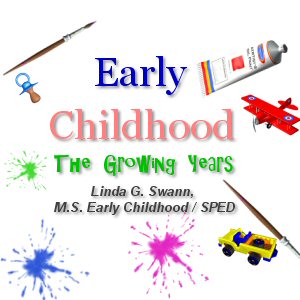Articulation
 Communication/language is one of the six domains, gross motor, fine motor, cognitive, language, self help/adaptive, and social/emotional, in early childhood development. We communicate through body language or movements, written language and spoken language. Body language begins in infancy and continues throughout our lifetime. Written language begins with marks on paper, coloring, and scribbling. Spoken language begins with sounds and progresses to words, phrases and sentences, and involves both receptive and expressive skills. Receptive language is knowing a word and “owning” it’s meaning. There must be fifty of these words to begin expressing language. Expressive language is words we remember, and can produce through sounds.
Communication/language is one of the six domains, gross motor, fine motor, cognitive, language, self help/adaptive, and social/emotional, in early childhood development. We communicate through body language or movements, written language and spoken language. Body language begins in infancy and continues throughout our lifetime. Written language begins with marks on paper, coloring, and scribbling. Spoken language begins with sounds and progresses to words, phrases and sentences, and involves both receptive and expressive skills. Receptive language is knowing a word and “owning” it’s meaning. There must be fifty of these words to begin expressing language. Expressive language is words we remember, and can produce through sounds.
While most often the cause for delayed language is too few receptive words, sometimes it is due to difficulties in production of the sounds (articulation). The first function of the infant’s mouth is sucking. The mouth must become ready to make sounds much like an athlete trains for an event. The infant’s training is automatic, resulting from normal activities as he/she matures. Exercising the mouth and tongue can enhance sound production. Children learn best through interesting and fun activities. If your child rebels from an activity, think of a more creative way to make it happen.
When children have language problems, it is usually either receptive or expressive, not both. If you think your child is late speaking, determine how many words are in his/her receptive vocabulary. This can be done by asking your child to “pick up” certain objects, getting the object without help or cues, he/she “owns” that word. Remember nothing is said except, “bring me the ____”, then wait. If nothing is retrieved, teach the word by often referring to it by name. (“Look, a block. Give me the block. Let’s find a block, etc.)
Activities to help exercise the muscles of the mouth to increase articulation skills, include blowing for better breath control. To produce sound and breath, your child has to coordinate breathing with sound production. Gently blow on your child, allowing him/her feel the breath, see the mouth movement and eventually attempt to imitate. Blow bubbles and pop them. Have a cotton ball race (blow cotton balls across the table to the finish line). Blow feathers in the air. Blow through a straw to make bubbles in water. Blow the bunny into his hole (bunny is cotton ball and the hole is a cup). Blow dandelions. Use your imagination to expand on these activities. Blowing will be difficult, so be patient and keep modeling.
Chewing also strengthens the mouth and jaw muscles necessary for good sound production. Straws are great things to chew on. Baby teething cookies not only help the gums, but encourage chewing (or gumming). Teething toys are good for chewing. Toddlers should have some crunchy and chewy foods in their diet. Often, creamy textures are continued, without adding other textures, way too long. Be aware of what will and will not choke your child. Chewing on fingers is a natural way to develop mouth and jaw muscles, necessary for eating and talking.
Tongue exercises are important and should begin in infancy. Your child will imitate you, so stick your tongue out as far as you can. Move your tongue from side to side (slow and then fast). Touch your tongue to your nose and to your chin. Continue these exercises with your toddler, but include a mirror to see the funny faces. Your toddler can be a kitty, lapping up milk from a platter. Let your imagination go wild it is fun for both Mom and child.












